国际会议交流英语pptUnit6 Preparing a Speech
- 格式:ppt
- 大小:237.00 KB
- 文档页数:50

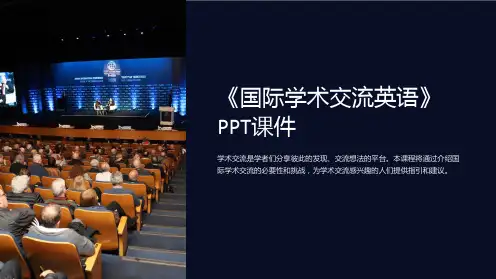
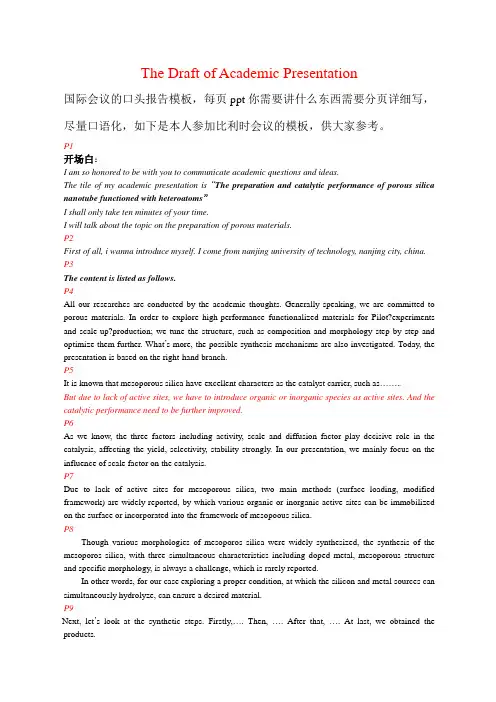
The Draft of Academic Presentation国际会议的口头报告模板,每页ppt你需要讲什么东西需要分页详细写,尽量口语化,如下是本人参加比利时会议的模板,供大家参考。
P1开场白:I am so honored to be with you to communicate academic questions and ideas.The tile of my academic presentation is “The preparation and catalytic performance of porous silica nanotube functioned with heteroatoms”I shall only take ten minutes of your time.I will talk about the topic on the preparation of porous materials.P2First of all, i wanna introduce myself. I come from nanjing university of technology, nanjing city, china.P3The content is listed as follows.P4All our researches are conducted by the academic thoughts. Generally speaking, we are committed to porous materials. In order to explore high-performance functionalized materials for Pilot?experiments and scale-up?production; we tune the structure, such as composition and morphology step by step and optimize them further. What’s more, the possible synthesis mechanisms are also investigated. Today, the presentation is based on the right-hand branch.P5It is known that mesoporous silica have excellent characters as the catalyst carrier, such as……..But due to lack of active sites, we have to introduce organic or inorganic species as active sites. And the catalytic performance need to be further improved.P6As we know, the three factors including activity, scale and diffusion factor play decisive role in the catalysis, affecting the yield, selectivity, stability strongly. In our presentation, we mainly focus on the influence of scale factor on the catalysis.P7Due to lack of active sites for mesoporous silica, two main methods (surface loading, modified framework) are widely reported, by which various organic or inorganic active sites can be immobilized on the surface or incorporated into the framework of mesopoous silica.P8Though various morphologies of mesoporos silica were widely synthesized, the synthesis of the mesoporos silica, with three simultaneous characteristics including doped metal, mesoporous structure and specific morphology, is always a challenge, which is rarely reported.In other words, for our case exploring a proper condition, at which the silicon and metal sources can simultaneously hydrolyze, can ensure a desired material.P9Next, let’s look at the synthetic steps. Firstly,…. Then, …. After that, …. At last, we obtained the products.P10In this work, by changing the synthesis conditions, such as …, and so on, the pure mesoporous silica with different morphologies were synthesized, including nanosphere, nanorod, helix, capsule and nanotube. We will focus on the preparation and catalytic application of mesoporous silica with nanotube morphology.P11the SEM images of samples: A1, A2, A3 are shown in the figure. It can be seen that sample a1 is nanowire-like with length of about 2μm and diameter of about 100nm. When the amount of ... is 0.04 g, the morphology of sample A2 became to be short and thick rods and the size is about 1μm in length and 400nm in diameter, respectively. With further increasing the amount of ..., the sample A3 and A4 turned to be spherical morphology. It also can be seen that the diameters of samples A3 and A4 are substantially the same about 450nm. However, the spherical morphology of A4 is more regular than that of A3.The XRD patterns showed four reflection peaks attributed to (100), (110), (200) and (210), respectively, due to the hexagonal sructure.P12Then, we keep the same amount of ..., increasing the amount of ....We found that the length increased gradually. The XRD patterns also showed the hexagonal sructure of samples B1, B2, B3, B4.P13Moreover, an additional proof of the hexagonal symmetry structure is given by TEM and the FT pattern. The N2adsorption-desorption isotherms of the samples B1, B2, B3, B4 exhibit a typical type-IV isotherm.According to the table of structural parameters, we can find that the specific surface area and total pore volume increase gradually, the thickness of wall decrease and there is no obvious change in diameter.P14Furthermore, the possible synthesis mechanism of the mesoporous silica nanotube in dual templates system was proposed. We suggest that due to electrostatic repulsion between positively charged ammonium ions from hydrated ammonia molecules and hydrophilic groups of ..., especially in ammonia (NH3, 25wt.%) solution, the high concentrated ammonium ions provide a crowded and repulsive space to prevent the conjunction of ... molecules, leading to the formation of the rod-like micelles as template to form pore structure instead of sphere-like ones.The role of co-template ... is suggested to tune the length of rod-like micelles by arranging itself along the axis of channel with PEO and PPO part immersed in the hydrophilic and the hydrophobic group of CTA+ respectively. As a result, the mesoporous nanotube with different length will be synthesized. However, the non-polar ... micelles are not affected by positively charged ammonium. When the amount of co-template increased further, the non-polar ... micelles tend to control the morphology of micelles which are sequentially from nanotube, short rod to sphere-like ones. It my be the reason that the non-polar ... micelles would provide stronger attractive force than the electrostatic repulsion derived from the PEO block, ammonium ions and head group of ..., respectively.P15In order to investigate the influence of the morphology and structure of mesoporous silica on catalytic performance, the samples with copper incorporated were synthesized.P16The figure shows the SEM and TEM images of samples a1, a2, a3, from which we can see they represent incremental length in the range of about 0.5, 1.0 and 1.5μm, and insignificant change in diameter around100nm. In XRD patterns, there are also four reflection peaks for the samples with copper incorprated, respectively, which indicates the incorporation of the inorganic copper salt has no obvious effect on the hexagonal sructure and the ordered degree of pore structure. Moreover, the trends in length and the diameter of nanotube are illustrated.P17The N2adsorption-desorption isotherms of the samples a1, a2, a3 exhibit a typical type-IV isotherm according to the IUPAC classification and no hysteresis loop at the relative pressure range of 0.2≤p/p0≤0.4, implying the samples not only have ordered mesoporous structure but also the uniform pore size. Moreover, the pore diameters did not change significantly at different weight ratio of .../.... The most probable pore sizes of samples a1, a2, a3 are determined to be 2.71, 2.50, 2.44 nm, respectively. The structural parameters are listed in following table.P18This table summarized the catalytic activity of copper-modified porous silica nanotube in the direct hydroxylation of benzene with H2O2 as oxidant. The catalysts showed high catalytic activity, and direct proportional relationship between the benzene conversion and the length of the silica nanotube. Considering the similar copper content determined by ICP, the variations of catalytic activities were probably caused by different retention time of reagent in the nanotube with different lengths.P19It is Summary and Future ResearchThis part of research can be summed up from the following three aspects.Mophology control,Catalytic activity and Future research看this slide.P20thanks。
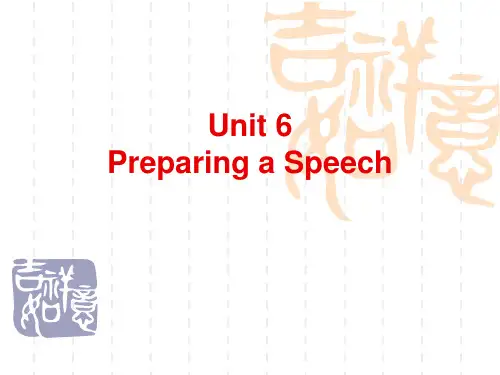
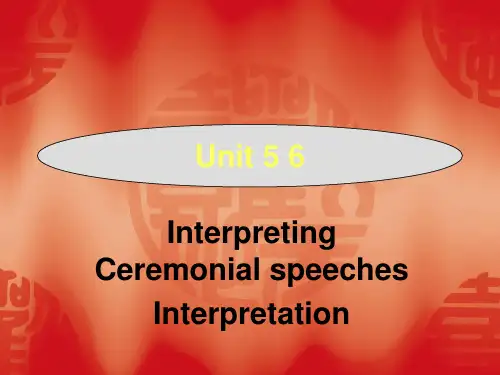
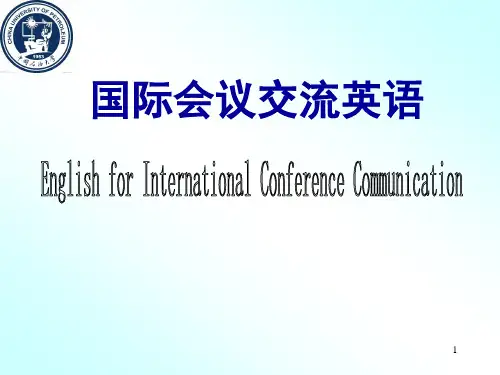
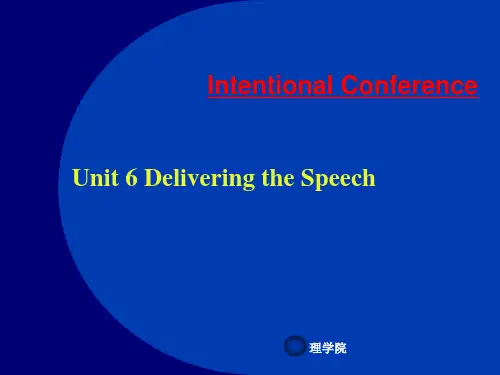

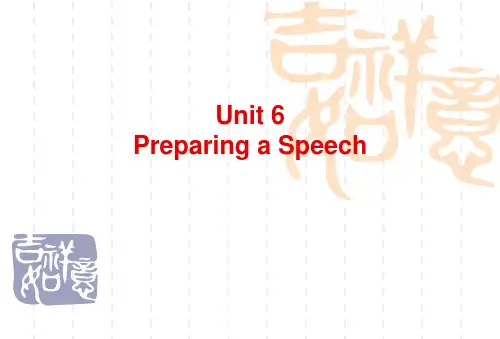
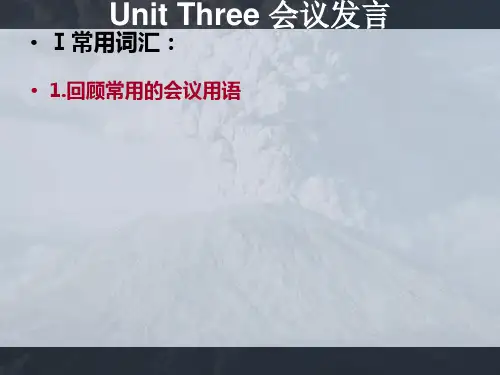
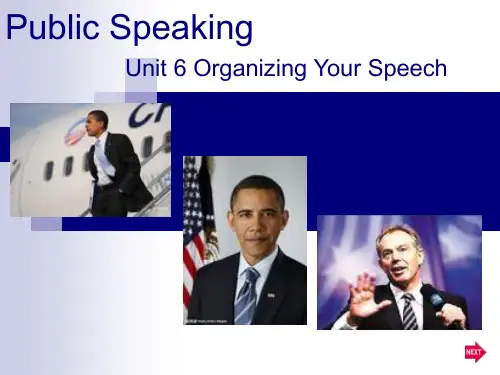
2016级国际会议交流期末复习题Part 1. multiple choice1) If there are more than ______ persons coming together, talking and discussing, the event can be called a meeting.A. fiveB. twoC. threeD. six2) Paper Submission Information of a conference is instructive and informative, including information on: ______, full test, and mode presentation.A. abstractB. titleC. topicD. keywords3) Before a conference, the possible contact persons are usually the ______, the chairperson, leading figures of the committees concerned, and the like.A. other participantsB. audienceC. expertsD. secretary-general4) If an invitation cannot be accepted due to certain reasons, a letter of ______should be sent to the inviter.A. invitationB. inquiryC. declinationD. apology5) Since conferences have channels for raising funds for operation, participants maybe have the opportunity of applying for financial assistance from the ______.A. conferenceB. committeeC. universityD. society6) Conference paper writing belongs to ______ writing, following the stylistic features of professional papers.A. non-specialistB. professionalC. regularD. informal7) The title of a paper should be concise. Generally, a title is supposed to be no more than ______ words.A. 20B. 25C. 10D. 158) An abstract is a succinct _____ of a longer piece of work, usually academic in nature.A. inductionB. deductionC. summaryD. debate9) The keywords of a conference paper should be carefully chosen, making sure that they match the _____ of the conference.A. structureB.venueC. organizerD. theme10) A(n) _____, or indicative, abstract usually states the general subject matter of the document that follows. It. Tells in an all-round way what the paper or report contains.A. informativeB. descriptiveC. informative-descriptiveD. instructive11) One of the core elements of an abstract is the principal _____ of a paper or research.A. wordsB. conclusionC. authorD. grant12) A topic sentence always goes straightforward to the subject or the problem and indicates the primary _____ of the paper.A. subjectsB. objectsC. subjectivesD. objectives13) The Latin word “et cetera”, abbreviated as “etc.” means _____ in English.A. aboutB. namelyC. and so forthD. and others14) A _____ may function as reference for citation, emphasis or special meaning.A. dashB. commaC. dotD. quotation mark15) Which of the following is not the proper way of ending a speech?A. Direct wind-upB. Brief summaryC. Showing greetingsD. Solicitation of comments16) With expressions l ike “since 1978” or “at the beginning of this month”, we are using _____sequence.A. ChronologicalB. PersonalC. SpatialD. Conception17) When we develop a speech “from concrete to abstract”, we are using the way of ____.A. DeductionB. InductionC. NarrationD. Explanation18) When giving expressions like “nearly 500” or “over 33 percent” or “something like”, we are using ______words.A. CrazyB. FuzzyC. LazyD. Dizzy19) Which of the following is not the features of on-the-spot question?A. ExtensivenessB. UnpredictabilityC. TimelinessD. Productivity20) By saying “I don’t quite understand what you really mean by saying... Can you explain it again?” We are asking __________.A. Questions for clarifying problemsB. Questions for showing special interestC. Questions for raising different opinionsD. Questions for challenging21) ______ is a kind of formal meeting, often lasting for a few days. It is organized on a particular subject to bring together people who have a common interest.A. ConferenceB. ForumC. SeminarD. Workshop22) The ______information usually includes the number of participants, the requirements for attendees, the conference VIPs and other persons the participant may specially want to meet and talk with.A. organizationsB. committeeC. sectariesD. participants23) Among various kinds of correspondence channels available, ______still remains essential and effective.A. messageB. letter writingC. phone callD. notes24) In order to get information about a conference, or to find out areas of interest, the potential participant may write a letter of ______.A. inquiryB. invitationC. declinationD. apology25) Generally speaking, a letter of application for financial aid should include the name of the meeting, the special reasons for application, and the specific ______.A. amountB. requestsC. contentD. address26) The writer of informal writing will use an informal tone, colloquial language. And usually the ______person is employed, as in letters, diaries, stories, etc.A. secondB. thirdC. firstD. last27) The number of keywords of a conference paper is limited. ______keywords are average. In general, there should be at least two and at most ten.A. 4-6B. 2-5C. 3-7D. 4-828) The _____ sentence is usually followed by a few supporting sentences which further specify the subject to be presented.A. debateB. argumentC. conclusionD. topic29) A(n) _____, or informational, abstract highlights the method and findings briefly but quantitatively.A. destructiveB. informativeC. informative-descriptiveD. instructive30) The Latin word “et cetera”, abbreviated as “etc.” means _____ in English.A. aboutB. namelyC. and so forthD. and others31)The keywords of a conference paper should be carefully chosen, making sure that they match the _____ of the conference.A. structureB.venueC. organizerD. theme32) A _____ is usually used for supplementation or explanation of what is mentioned previously.A. dashB. commaC. dotD. quotation mark33) _____ abbreviations are frequently used in scientific writing for international readers.A. FrenchB. LatinC. ChineseD. Greek34) One of the core elements of an abstract is the principal _____ of a paper or research.A. wordsB. conclusionC. authorD. grant35) Which of the following is not the general techniques for answering questions?A. Listing to questions carefully.B. Showing indifference to some questionsC. Judging questions correctly.D. Answering questions partially.36) Statement like “I ’m so sorry to say that the remarks in your question should be regarded as less than friendly” may be answer to __________.A. Ordinary questionsB. Noncommittal questionsC. Rebuking questionsD. Questions of disagreement37) Which of the following is not the causes for avoiding direct answers?A. Limitation of authorizationB. Lack of certain knowledgeC. Language barriersD. Being not in the mood38)When giving expressions like “nearly 500” or “over 33 percent” or “something like”, we are using ______words.A. CrazyB. FuzzyC. LazyD. Dizzy39) Which of the following is not the features of on-the-spot question?A. ExtensivenessB. UnpredictabilityC. TimelinessD. Productivity40) By saying “I don’t quite understand what you really mean by saying... Can you explain it again?” We are a sking __________.A. Questions for clarifying problemsB. Questions for showing special interestC. Questions for raising different opinionsD. Questions for challenging答案:1-5:BADCA 6-10:BDCDB 11-15:BDCDC 16-20: ABBDA21-25:ADBAB 26-30:CADBC 31-35: DABBB 36-40: CDBDAPart II. Match the words or expressions with their equivalence.参考答案:41-45 B D A F C 46-50 E N L O K 51-55 M G H I J 56-62. VUTSRQPPart three. True or false1.Meetings only include conference, symposium, convention, forum, seminar, workshop and colloquium.( )2.General assembly is usually attended by all the meeting participants and sometimes by government officialsas well as reporters. ( )3. A complete formal letter is usually composed of six parts: return address (addressor), inside address(addressee ), salutation , body, close, and signature. ( )4.The format of the letter or e-mail to important people involved in the conference is relativelyrigid, but the style in general is informal. ( )5. The title of a professional paper should be brief , concise, specific, unified, and standard. ( )6. Keywords have the following linguistic features: more nouns, limited numbers and designated choice.( )7. Abstracts can be classified into three categories: descriptive, informative, and informative-descriptive.( )8. Generally, the only way to express the chemical substances in English is reading the individual alphabet letterand number. ( )9. The abbreviation i.e. means “that is to say”. ( )10. If you are preparing a speech at a conference, you need to plan delivery, paraphrase key points, consider theaudience and practice aloud. ( )11. If a speech is to communicate a speaker’s thoughts to an audience, it is better to meet the followingrequirements: to be easy to comprehend, to be complete and balanced, and to be considerate to audience.( )12. When greeting the participants of a meeting and expressing your thanks to the chairperson, you should tryyour best to show your effusiveness and compliments to establish goodwill. ( )13. Approaches to ending a speech include direct wind-up, brief summary and solicitation of comments.( )14. You can develop a speech in chronological sequence, or according to spatial relation, or by induction or bydeduction.. ( )15. In oral presentation, we can only use accurate words or expressions to avoid misunderstanding. ( )16. At a conference, to fill the silence caused at the time of a long break, we may adopt the following approaches:talking something unimportant, or repeating the main point which has been covered previously. ( )17. On-the-spot questions have the following features: extensiveness, predictability, and timeliness. ( )18. In a discussion session, the question-raisers are usually outsiders of the field. They are not familiar with thepresentation content. ( )19. In order to effectively answer the questions raised at a discussion session, you need to listen to the questionscarefully, and judge the questions correctly, and sometimes, you can copy the original questions pattern or even repeat the related content from the previous presentation. ( )20. All questions raised at a discussion session should be clearly and directly answered. ( )21. S y m p o s i u m is a kind of formal meeting, often lasting for a few days. It is organized on a particular subject to bring together people who have a common interest. At a conference, formal discussions usually take place. ( ) 22. Whether or not the invitation is accepted, the invitee should not give a timely response, so that the inviter can go on with further arrangement. ( )23. Consultative tone is hard to define because there are some discipline-specific differences. Each consultative discipline has its own conventions. ( )24. The format of a conference paper is generally conference-specific and must be in conformity with the standard set forth by the specific conference. ( )25. Since revision is tedious, it is necessary to stress that the final manuscript is to be covered from the beginning to the end to make sure that the changes made do not call for additional modifications anymore. ( )26. An abstract is a shortened version of the paper and only contains the significance of the results for the reader to determine. ( )27. The integrity of an abstract should include research theories, research methods, investigations, experimental results and conclusions. ( )28. Manuscript reading prior to a conference is actually building a bridge over the gap between written text and oral presentation, which links the skills of writing and speaking together and shows the presenter's overall language proficiency. ( )29. In reading, punctuation marks such as parentheses/brackets, comma, quotation marks, dash, dots, slant and so on are demonstrated by printed symbols which may not cause any misunderstanding. ( )30. Various formulas, such as mathematical expressions, chemical formulas and other equations, are considered as one of the most difficult points in the practical reading of professional papers. ( )31. An organizational pattern is inappropriate supporting forms and insufficient supporting materials. ( )32. Four general criteria in preparing a speech are: Easy to Comprehend; Complete and balanced; Considerate to Audience and Coherent and organic. ( )33. Apologetic beginnings are usually adopted in a Chinese cultural context though there are some changes nowadays. ( )34. Highlighting the main points can remind the audience of asking questions about procedures or ideas that they do not fully understand or that they are specially interested in. ( )35. A speaker should not adjust the volume of his/her voice in accordance with the degree of the audience's familiarity and interest in the subject, as well as the acoustic effect of the conference hall. ( )36. To develop a speech on the basis of experimental procedures can either help the speaker explain step by step the ides or enable the listeners to receive the information in an orderly way. ( )37. Deduction mains the speaker provides the supporting material first, and then generalizes and draws a conclusion. ( )38. Fuzzy expressions can help to round off complicated numbers, if they are not very significant in the context of the discussion. ( )39. Since questioners are usually those who have attended the speech session of a speaker, they have obtained a rather comprehensive understanding of the content. Therefore, questions by such questioners are usually in-depth, of narrower range, and difficult. ( )40. When the speaker intends to point out the mistakes of the questioner or contradict his / her idea, euphemistic style is particularly necessary. ( )本部分参考答案:1 -5 F T T F T 6-10 T T F T T 11-15 T F T T F 16-20 T F F T F21—25 FFFTT 26—30 FTTFT 31—35 FTTTF 36—40 T F T F TPart four(根据括号中的要求完成任务)1)All text is aligned to the left margin, double spaced between paragraphs in the body. (According to international practice, there are two styles in letter writing. Tell what style is it according to the description.)2) 0< x < 1(express the formula in English)3) circumference (put it into English)4) It has also provided the bases for the traditional methodology of science: objective observation and description of some phenomena, the formulation of a hypothesis or hypotheses about the events observed and possible relationships among them, the use of these to predict future events, theverification of the hypotheses and, on this basis, the construction of a theory of some area of natural activity. (divide sense groups)5) A class-like meeting, where participants discuss a particular topic or subject that is presented by several major speakers. In American universities, the term refers to a course of intense study relating to the students’ major. (what kind of meeting is it?)6) Nowadays, many speakers take advantage of audiovisual aids at a conference (list at least three kinds of audiovisual aids)7) The battery output power was 0.9733 mW (use fuzzy words to replace the specific figure).Mr. Chairman, ladies and gentlemen, the title of my presentation is …(point out the approach to opening a speech taken here).9)…Here, Xm represents the magnetic-susceptibility. Now let’s assume Xm to be constant, then the following formula can be obtained easily…(point out the measure adopted here to simplify long term)10) For the time being, I will just answer your question like this…(point out the strategy adopted here for avoidance in Q & A session)11 )A. closing ceremony B. welcome speeches by government officials and organizers C. opening ceremony D. general speeches given by distinguished guests or outstanding experts (Arrange the order of the major activities at a general assembly)12) Summarize the general functions of the title of a professional paper.13) A. It tells in an all-round way what the paper or report contains.B. Instead of indicating the general content, it should be specific and quantitative, giving only essential data. (Which is the feature of informative abstract?)14) (NH₄)₂Cr₂O₇ (express the formula in English)15) … in other words, the a verage variation of△H illustrated in Fig. 4 by heavy lines agrees well with the change of exospheric temperature which is the equation of No. 5 even though the diurnal behavior of △H on an individual day is controlled not only by the change of exospheric temperature but also by all kinds of exospheric disturbances taking place at any height. (divide sense groups) 16) If a speech is to communicate a speaker’s thoughts to an audience, it is better to meet some requirements (write down the three requirements specifically).17)…That’s all. Thank you, Mr. Chairman. Thank you all. (point out the approach to ending a speech taken here)18) To facilitate our illustration, I only say a few words about the first line, the middle line, and the last line on this spectrum. For the first line, the peak in the middle is the quartet peak of CH2, the left one is the single peak of C6H5, while the right one is the triplet peak of CH3 and the TMS peak at the extremely right side (point out the approach to developing a speech taken here).19) I don’t quite understand what you really mean by saying “all these phenomena are interrelated”.Can you explain it again? (point out the type of question raised here in Q & A session)20) Mr. Chairman, just now a gentleman in the back row asked me a question, but I didn’t quite understand what it was. Could you explain it to me? (point out the strategy adopted here for avoidance in Q & A session)本部分参考答案:1) block style2) Zero is less than x, and x is less than one3) 圆周4) It has also provided the bases for the traditional methodology of science: // objective observation and description of some phenomena,// the formulation of a hypothesis or hypotheses about the events observed // and possible relationships among them,// the use of these to predict future events, // the verification of the hypotheses and, on this basis, //the construction of a theory of some area of natural activity.5) Seminar6) overhead projectors, lantern slides, videotapes, recordings…… (list 3 of them will be enough)7) The battery output power was something like 1 mW.8) Begin by straightforwardness.9) Use symbols.10) Temporarily tabled.11) CBDA12) generalizing the text; attracting the reader; facilitating the retrieval13) B14) open bracket N H four close bracket twice C r two seven15) … in other words, // the average variation of△H // illustrated in Fig. 4 by heavy lines // agrees well with the change of exospheric temperature // which is the equation of No. 5 // even though the diurnal behavior of △H // on an individual day // is controlled not only by the change of exospheric temperature // but also by all kinds of exospheric disturbances // taking place at any height.16). Be easy to comprehend; be complete and balanced; be considerate to audience.17). Direct wind-up.18) Develop a speech according to spatial relation19). Question for clarifying problems.20). Attention-shifting.Part 5. AbstractDirection: Find the likely mistakes and common errors in the abstract writing and polish the abstract. (考查写摘要的能力。
Unit 6 Application, Curriculum Vitae and Personal StatementTask 1Curriculum vitae [kəˌrɪkjələm'vitaɪ] 简历Association [əsəʊsɪ'eɪʃ(ə)n; -ʃɪ-] n. 协会,联盟,社团Unambiguously [,ʌnæm'bigjuəsli] adv. 不含糊地;明白地Aspiration [æspə'reɪʃ(ə)n] n. 渴望;抱负;呼气Differentiate [,dɪfə'renʃɪeɪt] v. 区分,区别Complementary [kɒmplɪ'ment(ə)rɪ] adj. 补足的,补充的Learning aidsCorrespondence [kɒrɪ'spɒnd(ə)ns] n. 通信;一致;相当Connection [kəˈnekʃn] n. 连接;关系;Eligible ['elɪdʒɪb(ə)l] adj. 合格的,n. 合格者Admittance [əd'mɪt(ə)ns] n. 进入;入场权Forthcoming [fɔːθ'kʌmɪŋ]adj. 即将来临的n. 来临Automation [ɔːtə'meɪʃ(ə)n] n. 自动化;自动操作Pursue [pə'sjuː] v. 继续;从事;追赶;纠缠Dramaturgical [,dræmə'tə:dʒikəl] 戏剧作法的Dramaturge ['dræmətɝdʒ] n. 剧作家Reproductive [,riːprə'dʌktɪv] adj. 生殖的;再生的Optimization [,ɒptɪmaɪ'zeɪʃən] n. 最佳化,最优化Co-founder n. 共同创立者Ideological [,aɪdɪəʊ'lɒdʒɪkəl] adj. 思想的;意识形态的Biomedical [baɪə(ʊ)'medɪk(ə)l] adj. 生物医学的Optoelectronic [,ɒptəʊɪ,lek'trɒnɪk] adj. 光电子的Conservation [kɒnsə'veɪʃ(ə)n] n. 保存,保持;保护Nonintrusive 无妨碍的,非干涉的Rigor ['rɪgɚ] n. 严厉;精确;苛刻;僵硬Obliged [ə'blaɪdʒd] adj. 必须的;感激的;有责任的Task 2Doctoral ['dɒkt(ə)r(ə)l] adj. 博士的;博士学位的;n. 博士论文Affiliation [əfɪlɪ'eɪʃ(ə)n] n. 友好关系;加入;联盟;从属关系Learning aidsUnderneath [ʌndə'niːθ] prep. 在…的下面;在…的形式下;在…的支配下adv. 在下面;在底下n. 下面;底部adj. 下面的;底层的Document ['dɒkjʊm(ə)nt] n. 文件,公文Reverse [rɪ'vɜːs] n. 背面;相反;倒退;失败vt. 颠倒;倒转adj. 反面的;颠倒的;反身的Coordinate [kəʊ'ɔ:dɪneɪt] n. 坐标;同等的人或物adj. 并列的;同等的v. 调整;整合,协调Customize ['kʌstəmaɪz] vt. 定做,按客户具体要求制造Implement ['ɪmplɪm(ə)nt] vt. 实施,执行;n. 工具;手段Innate [ɪ'neɪt; 'ɪneɪt] adj. 先天的;固有的;与生俱来的Install [ɪn'stɔl] vt. 安装;任命;安顿Resolve [rɪ'zɒlv] v. 决定;溶解,解决;n. 坚决;Gerund ['dʒerʌnd] n. 动名词Portion ['pɔːʃ(ə)n] n. 部分;一份;命运vt. 分配;给…嫁妆Parallel ['pærəlel] n. 平行线;对比adj. 平行的;类似的Boldface ['bəʊldfeɪs] n. 黑体字;粗体铅字Indent [ɪn'dent] vt. 定货;缩排;印凹痕vi. 切割成锯齿状n. 缩进;订货单;凹痕;契约Punctuation 美['pʌŋktʃʊ'eʃən] n. 标点;标点符号Criticism ['krɪtɪsɪz(ə)m] n. 批评;考证;苛求Aesthetic [iːs'θetɪk; es-] adj. 美的;美学的;审美的Quantitative ['kwɑntətetɪv] adj. 定量的;量的,数量的Macro-modulation [,mɒdjʊ'leɪʃən] 宏观调控Peril ['pɛrəl] n. 危险;冒险vt. 危及;置…于险境Integrate ['ɪntɪgreɪt] vt. 使…完整;使…成整体;求…的积分;表示…的总和vi. 求积分;取消隔离;成为一体adj. 整合的;完全的n. 一体化;集成体Amicable ['æmɪkəb(ə)l] adj. 友好的;友善的Conscientious [,kɒnʃɪ'enʃəs] adj. 认真的;本着良心的;小心谨慎的Diplomatic [dɪplə'mætɪk] adj. 外交的;外交上的;老练的Extrovert ['ekstrəvɜːt] n. 外向;外倾者;性格外向者Introvert ['ɪntrəvɜːt] vt. 使内向;使内倾;使内弯n. 内向的人;内翻的东西Task 3Learning aidsPivotal ['pɪvətl] adj. 关键的;中枢的;枢轴的n. 关键事物;中心事物Subsequent ['sʌbsɪkw(ə)nt] adj. 后来的,随后的Reiterate [riː'ɪtəreɪt] vt. 重申;反复地做Tangible ['tæn(d)ʒɪb(ə)l] adj. 有形的;切实的n. 有形资产Errand ['er(ə)nd] n. 使命;差事;差使Stereotype ['sterɪə(ʊ)taɪp] n. 陈腔滥调,老套;铅版Revelation [revə'leɪʃ(ə)n] n. 启示;揭露;出乎意料的事Envision [en'vɪʒ(ə)n] vt. 想象;预想Therapist ['θerəpɪst] n. 临床医学家;治疗学家Upfront [ʌp'frʌnt] adj. 预付的;在前面的;正直的adv. 在前面;Substantive ['sʌbst(ə)ntɪv] adj. 有实质的;大量的;真实的;独立存在的n. 名词性实词;独立存在的实体Typographic [,taɪpə'græfɪk] adj. 排字上的;印刷上的Conscientiousness ['kɒnʃəsnɪs] n. 意识;知觉;觉悟;感觉Incorporate [ɪn'kɔːpəreɪt] v. 包含,吸收;体现;把……合并adj. 合并的;一体化的;组成公司的Foster ['fɒstə] vt. 培养;养育,抚育;抱(希望等)adj. 收养的,养育的Solidify [sə'lɪdɪfaɪ] v. 团结;凝固Congestion [kən'dʒestʃ(ə)n] n. 拥挤;拥塞;充血Impart [ɪm'pɑːt] vt. 给予(尤指抽象事物),传授;告知Effectiveness [ɪ'fektɪvnɪs] n. 效力Strenuously ['strɛnjʊəsli] adv. 勤奋地;费力地Exempt [ɪg'zem(p)t] vt. 免除;豁免adj. 被免除的;被豁免的n. 免税者;被免除义务者Mandatory ['mændət(ə)rɪ] adj. 强制的;托管的;命令的Diligence ['dɪlɪdʒ(ə)ns] n. 勤奋,勤勉;注意的程度Consultative [kən'sʌltətɪv] adj. 咨询的Asset ['æset] n. 资产;优点;有用的东西;有利条件;Judicial [dʒuː'dɪʃ(ə)l] adj. 公正的,明断的;法庭的;审判上的Compassionate [kəm'pæʃ(ə)nət] adj. 慈悲的;富于同情心的vt. 同情;怜悯Enhance [ɪn'hɑːns; -hæns; ] vt. 提高;加强;增加。